Companies that adopt innovative recruitment strategies succeed while others fall away. Sooner or later, all recruiters discover this truth. But what does taking an “innovative approach” to recruiting mean?
The answer’s not so clear, unfortunately, as innovation applies to every component of the recruitment process. However, statistics reveal that 76% of job seekers say a positive candidate experience influences their decisions to accept job offers. 52% say they’ve rejected offers due to a poor hiring experience.
The good news is that there are plenty of opportunities to design an innovative recruitment strategy. The even better news is that we’ve done the heavy lifting for you. Let’s explore some innovative recruitment ideas to help you refresh and improve how you hire.
TL;DR — Key Takeaways
Candidates increasingly expect a seamless experience from application to onboarding. Recruiters need efficient ways to source candidates, assess skills, and make the perfect hire. Sticking with what you know isn’t an option.
Creative recruitment strategies have several benefits. Wider talent pools ensure more relevant applications, for example. Innovation also boosts candidate engagement and promotes positive employer branding to attract more prospective candidates with the right skills.
Innovative recruitment tips fall into two categories: candidate sourcing and assessment. Creative sourcing ideas include using chatbots, niche job boards, and video intros. Podcasts, company pages, and social media content help attract candidates and manage a great talent pool.
Creative candidate assessment is important, too. AI grading analyzes complex candidate responses, for example, while skills tests simplify the task of parsing candidate abilities. Tools like Toggl Hire let you rank candidates based on role-specific skills, making it easier than ever to match skills and roles.

Importance of an innovative recruitment process
It’s no secret that life has changed quite a bit in the past few years. Everything from the way we live and work to the way businesses hire has undergone drastic change driven by digital advancements.
For those managing a recruiting strategy, this means that, unfortunately, the methods they’ve relied on for years (decades even) are either failing to deliver or giving way to slicker, more advanced alternatives.
Candidate expectations are shifting, too. Qualified potential candidates will likely use specialist job boards or personal networks to look for jobs, while an increasingly diverse workforce expects an inclusive recruiting process and a great company culture once they’re hired.
And we’re not just speculating here. Several studies reinforce the need for creative recruitment strategies to reach candidates in a tough job market:
78% of applicants misrepresent their experience or qualifications in resumes. In-depth background checks are becoming increasingly necessary to assess candidates fairly.
60% of applicants report poor candidate experiences, and 80% of disgruntled candidates share their feelings with others.
Gamified learning tools increase the ability of employees to assimilate information by up to 40%. This makes onboarding more efficient and reduces applicant drop-out rates.
Recruiters using skills tests report 36% higher satisfaction with their eventual hires. Targeted skills tests separate elite talent from mediocre candidates.
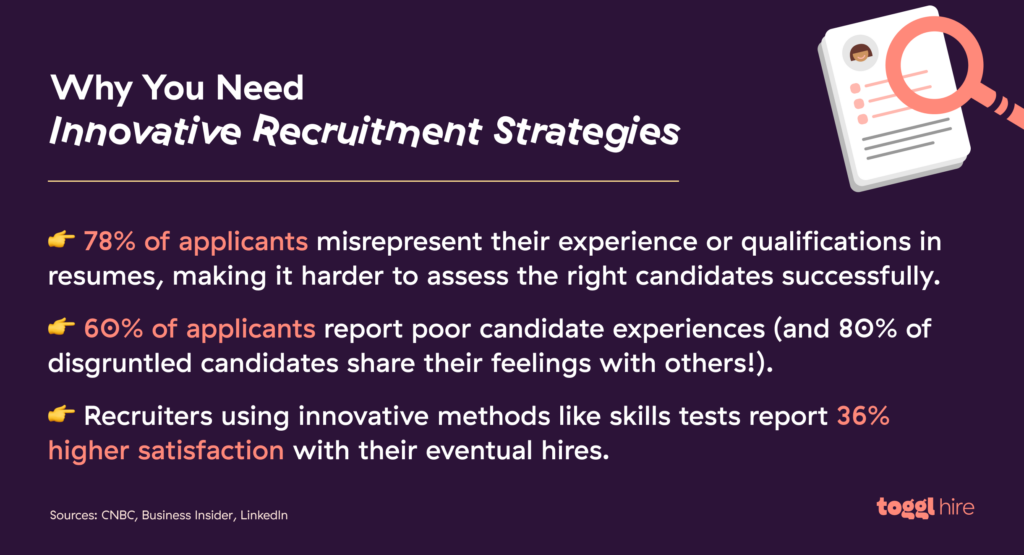
Basically, there’s no better time to revolutionize your recruitment strategy. If you still have doubts, consider the benefits of adopting a creative recruitment process:
Attracting top talent: Elite candidates avoid companies with a reputation for treating applicants poorly. Innovation helps improve the candidate experience, ensuring highly qualified candidates spread the word.
Widening your talent pool: Innovative recruitment strategies meet talent where they’re at and use targeted job ads to attract passive candidates who aren’t actively looking for jobs on a career page (but who are a great fit for your company and vice versa!).
Boosting your employer brand: Candidates assess employer branding, weighing factors like work-life balance, promotion prospects, DEI policies, and employee benefits. Innovative recruitment helps you showcase your unique employer proposition.
More efficient hiring: Innovation empowers your recruitment team to work more efficiently to achieve better results, from sourcing and writing job descriptions to assessing candidates, scheduling interviews, and onboarding successful hires.
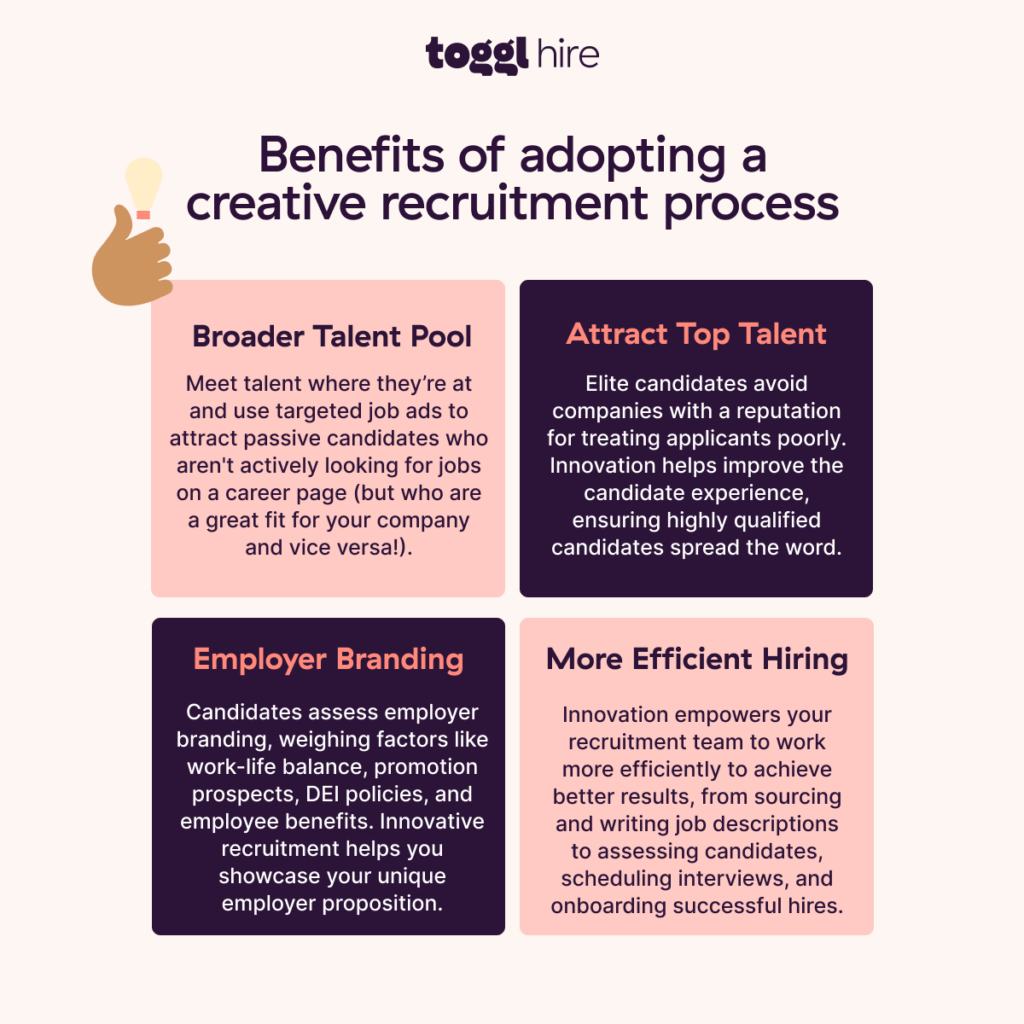
Innovative recruitment methods to attract candidates in 2024
The standard recruitment process has two main components: sourcing candidates and candidate assessments.
Both parts work together in the recruitment pipeline. However, we recommend separating assessment and sourcing when improving your recruitment process. Separating the two lets you focus on attracting talent and using innovative techniques to filter the best candidates.
With that in mind, here are a few out-of-the-box recruiting strategies to attract job seekers that don’t require you to rely solely on a careers page or social media platforms.
1. Add a career page chatbot
Chatbots may be frustrating when buying insurance or renting a car, but they are often ideal for responding to questions about job postings on your company website.
AI-powered bots these days are accurate enough to understand almost all candidate questions. They can send helpful documents for candidates to review, provide more background information about job postings, and even invite candidates to visit a certain page to get the application process rolling.
Don’t rely 100% on bots. The candidate experience should always feel organic and welcoming, so retain human points of contact with potential hires.
2. Explore text recruiting
With text messages, you can instantly convey information to candidates, informing them about submission deadlines or upcoming interviews. Personalized texts also humanize the early recruitment phase.
However, not all candidates respond well to texts. SMS messages can feel like spam, and because it’s a more informal channel, candidates may forget to read or respond. Also, consider compliance issues.
Text recruiting works well with younger audiences full of smartphone users (scroll down just a bit to see more unique ways to recruit younger talent). Double-check when sending critical messages, and think twice about relying on texts to recruit older or more senior employees.
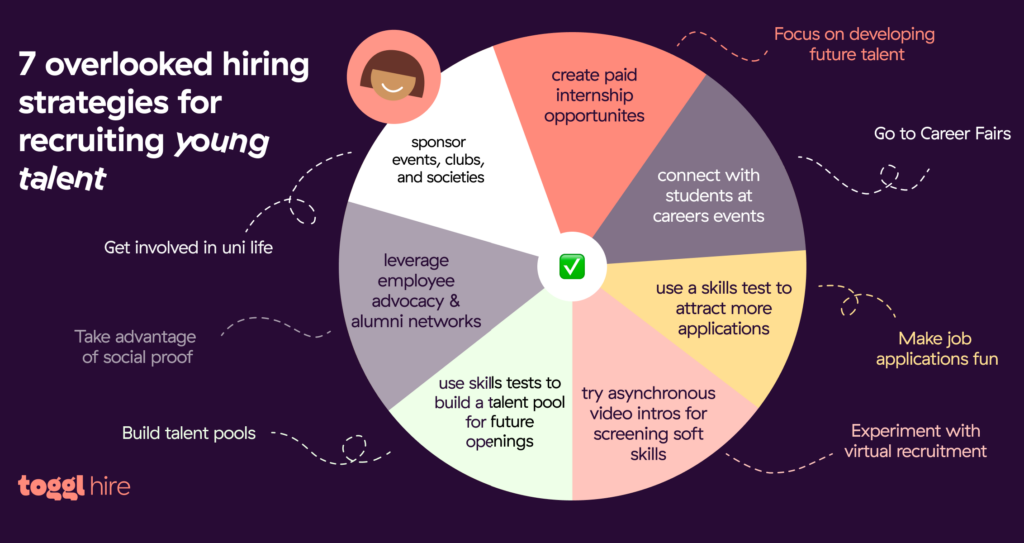
3. Record a company podcast
A recognizable and appealing employer brand is important in a saturated job market, but maintaining a positive public image requires an innovative approach. Internal podcasting could be the answer.
A company podcast could involve existing employees who discuss aspects of their work environment and the company culture. Depending on the industry you’re in and what kind of candidates you’re trying to attract, they may appreciate how the podcast provides a window into everyday working life.
Podcasts are popular with early and mid-career applicants. Aside from detailing internal activity, podcasts cultivate a progressive, employee-led brand — qualities that top talent tends to appreciate. A podcast is also a great way to attract more passive candidates by demonstrating your expertise.
4. Consider virtual reality
It’s still in its infancy, but virtual reality is already a new frontier in creative recruitment marketing. Some creative recruitment campaigns introduce prospective candidates to role responsibilities via virtual reality workplace tours.
Not everyone is familiar with or keen on VR technology. Poorly-made VR experiences that don’t capture the feel of workplaces or roles won’t engage potential candidates. If you can’t do VR well, it’s best to hold off — at least for now.
5. Explore niche job boards
Where you put job postings influences who applies. However, recruitment marketing is complex, and the best candidates don’t always frequent mass-market job boards. One easy win is turning to niche job platforms.
For example, accountants gather at the AICPA job board, while Crunchboard serves developers and engineers. Focusing solely on specialist areas is better than relying solely on traditional boards or job fairs.
You can broaden your talent pool further by posting jobs on specialist boards and sites for diverse communities like DiversityJobs.
6. Host recruitment events
Technology has made it cheaper and easier to host bespoke recruitment events where candidates can learn about roles and career paths. Use these events to boost your employer brand and make a powerful impression on every attendee.
In-person recruitment days are one option. However, hosting hybrid events usually makes more sense. These events combine Zoom sessions, video resources, and in-person talks or meetings.
Include content promoting your inclusive company culture and ensure all attendees have the same access to every aspect of the event. For instance, hiring a sign language specialist may be necessary to reach potential candidates with hearing difficulties.
7. Showcase strong employee benefits
In a tight labor market, potential hires care about more than wages. Attractive companies offer flexible work arrangements like accommodation for remote workers, paid sabbaticals, parenting leave, and more. Health benefits, counseling, and training all make attracting candidates easier.
Think about the type of benefits employees want and need. In some sectors, funding to study is the most important perk. If that’s the case, you could offer (like we do at all Toggl companies) an annual learning budget so employees can study and improve their skill set.
Regardless of what you choose, it’s important to create a benefits package tailored to your workforce. Not sure what they want? Survey candidates. Feedback could suggest ways to make your job advertisements and open positions more appealing.
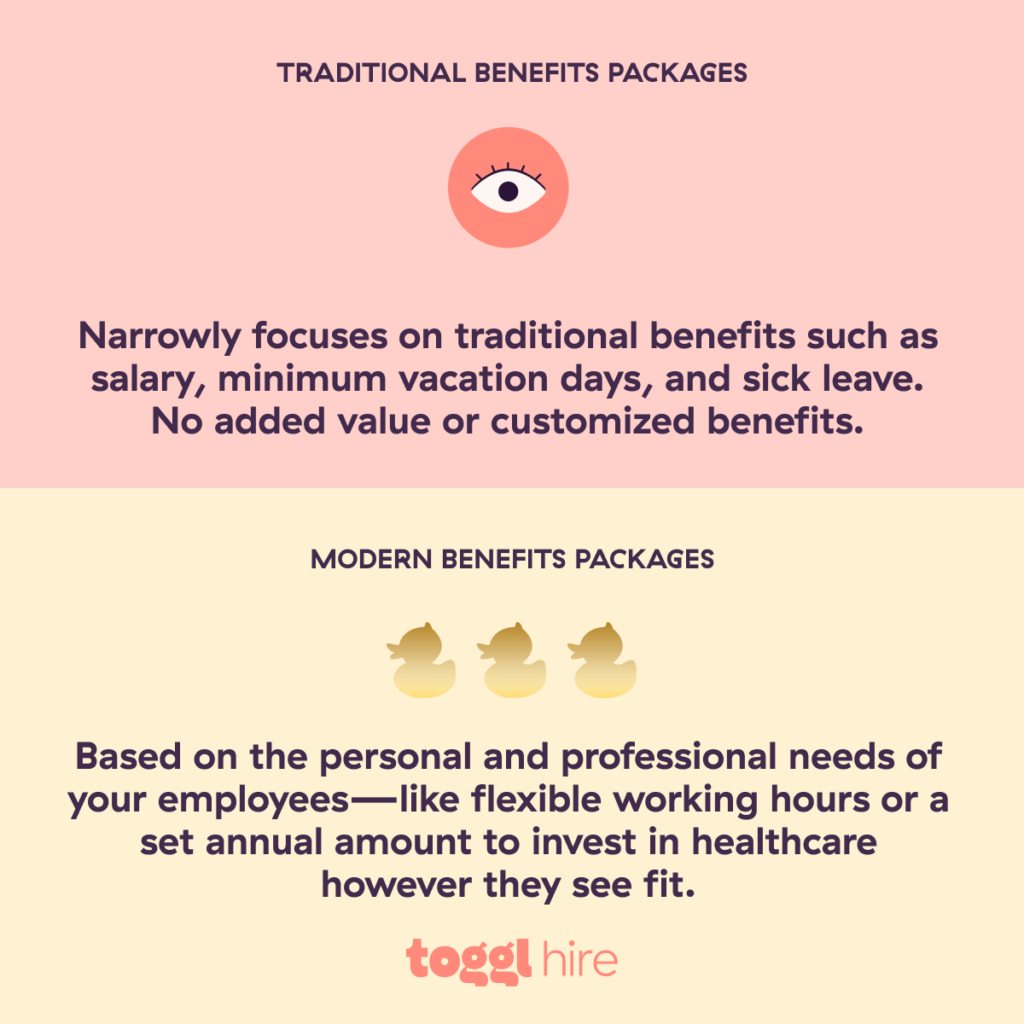
8. Create an employee referral program
While often overlooked, creative recruitment strategies that work rely on alternative methods to source new candidates. Employee referrals are often the most efficient way to hire, as current employees know how the company works and who would fit your company’s culture.
However, it’s easy to get referral programs wrong. Offer generous rewards for employee contributions, even if their leads don’t become hires. It’s also helpful to promote the referral program widely and send reminders when scheduling new job ads.
Check in with ex-employees, too (if they left on good terms). Their networks are likely full of potential candidates looking for relevant job openings.
9. Build an accessible talent community
Talent communities are like extensions of your workforce — they’re full of individuals interested in working for you who also have valuable skills. Social media platforms make it easier to manage communities. However, most recruiters need to take a proactive approach to keep top talent engaged.
Creating engaging recruiting content is a good start. For example, you can use your company blog to showcase each job posting, maybe via videos and interviews with managers. Maintaining a dedicated career page is also a must.
10. Use video intros
When hiring, use video introductions at the start of the process to attract candidates looking for a more human, personalized hiring experience.
Use a senior manager or HR professional to introduce the role, the company culture, or how new hires fit into the organization’s values. Intros also help you reach a wider audience, suiting busy smartphone users looking to interview on their own time — a significant part of today’s talent pool.
Keep the content short. We recommend making videos no longer than about two to five minutes. If you need to cut down the running time, prioritize including background information that helps candidates understand the role and its better.
Innovative recruitment methods to evaluate candidates in 2024
Innovative candidate sourcing gets you halfway to a hire. However, you’re not done yet — you still have to through resumes, schedule interviews, and assess candidate skills. Here’s how to innovate the evaluation part of any recruitment strategy.
11. Test candidates’ skills
Skills testing may be the most transformational creative recruitment idea on this list (and the easiest to implement!). Companies need to match skills to roles, but assessing those skills during a quick hiring process isn’t always so simple. Expertly crafted online tests are a simple off-the-shelf solution.
Skills tests objectively measure candidate abilities. As a recruiter, you can tailor tests to each role and its related core competencies. Automated analysis tools help you crunch the numbers, generating robust data about every applicant.
The best thing about this? Aside from saving time, there’s much less room for hiring bias to creep in, which ensures potential candidates are able to fairly compete with others while you benefit from more data-driven hiring results.
Toggl Hire specializes in skills testing, so this is a creative recruitment technique we know well. Check out our skills test library to explore soft and hard skills tests.
12. Use other gamification techniques
Skills tests make recruitment more user-friendly and enjoyable for candidates, but there are other ways to “gamify” the hiring process and engage talent.
Game-based assignments place candidates in real-life situations, challenging them to complete tasks in a setting that feels more like play than work. Online group “quests” are another option, especially if you’re looking for creative recruitment strategies that include group exercises.
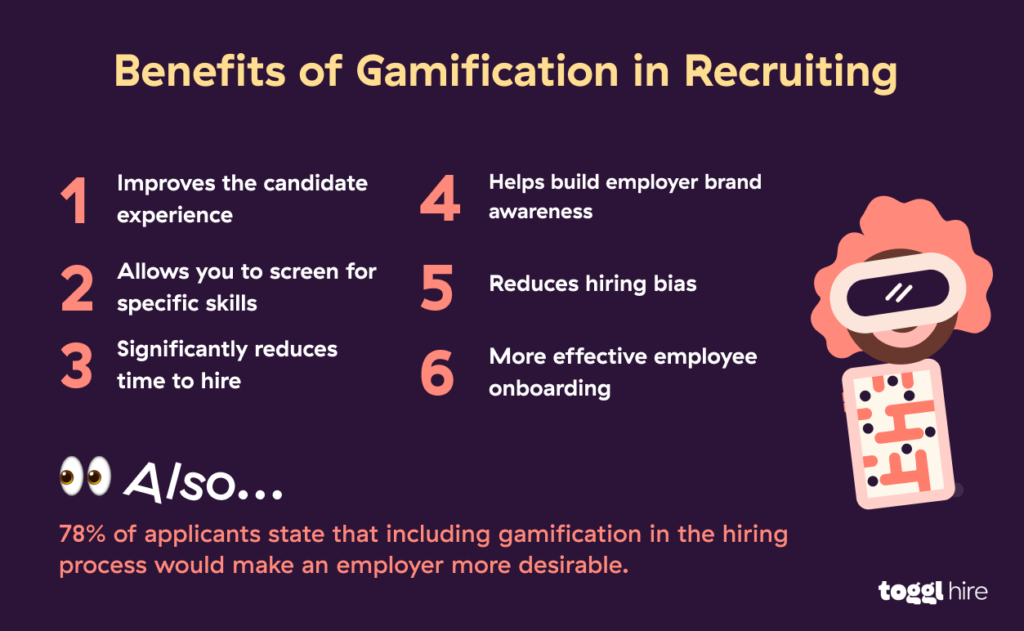
Gamification is best used when you’re looking for insights into problem-solving and communication capabilities. It’s also great if you’re trying to attract talent that is highly creative.
13. Try asynchronous interviews
With asynchronous interviews, recruiters send video questions instead of scheduling an in-person or synchronous video call, allowing candidates to record answers over a pre-defined period.
This interview method makes hiring at scale far easier because recruiters only need to record a single script. You also don’t have to take time out of your busy day to schedule (and attend) interviews. Asynchronous interviews also ensure a consistent candidate experience, cutting hiring bias.
The biggest benefit of async interviews for candidates is that they have time to think about their answers and draw on their experiences. Not everyone thrives under the spotlight of standard interviews, and this levels the playing field while also allowing you to widen your talent pool to attract the right candidates.
14. Assign (paid) take-home assignments
Take-home assignments are the perfect match for targeted skills testing. Assignments feature in-depth tasks related to actual work situations. They reveal how applicants will perform under pressure and assess whether candidates can put their skills into practice.
When creating homework assignments, remember candidates have limited time and don’t want to spend their evenings working for nothing. So, keep the assignments relatively short and to the point. Also, pay candidates for their time! We suggest using homework as the final shortlisting stage to choose between a small handful of potential candidates for job offers.
15. Auto-grade assessments with AI
Want to save time and reduce hiring bias? Use AI tools to automatically grade candidate responses. Advanced tools can interpret answers to open-ended and free-form questions. They can also analyze prose or speech, extracting insights about the personalities and abilities of potential candidates.
Don’t replace candidate assessment entirely with AI. Use AI and other smart technology to reduce the hiring workload and eliminate human biases. Use real humans at every touchpoint to verify answers or make hiring decisions.
Improve your hiring process with Toggl Hire
Hiring managers often stick with what works, even if older methods gradually lose relevance and effectiveness as the world moves on. Don’t let that happen to you — embrace creative recruitment strategies to avoid stagnation.
One great tool to implement in your recruitment strategy today? Toggl Hire. Using our ATS-like skills-based hiring platform, you can easily build and roll out creative recruitment solutions to test candidates, provide feedback, and grade responses efficiently.
Discover the future of recruiting by creating a free Toggl Hire account today.

Elizabeth is an experienced entrepreneur and content marketer. She has nine years of experience helping grow businesses and has experienced first-hand the impact of skills-based hiring in today's global, digital world.






